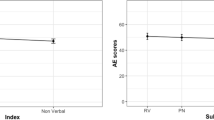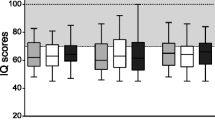Abstract
Cognitive development of early treated PKU children (132) was investigated by intelligence tests, tests for visual perception, motor and language development. Deviations from test norms occurred at 5 years of age concerning performance IQ, mathematical thinking, and visual perception. With the exception of mathematical thinking, “normal” results were obtained at the age of 6 years. Correlation with levels of plasma Phe revealed a relation between qualitiy of dietary control and performance IQ. Results are discussed in light of methodological aspects and with respect to treatment consequence.
Similar content being viewed by others
References
Eggert D (1972) Die Columbia Mental Maturity Scale als Individualtest für normal entwicklete Kinder im Alter von 3–10 Jahren. In: Eggert D (ed) Zur Diagnose der Minderbegabung. Beltz, Weinheim
Fisch RO, Sines LK, Chang P (1981) Personality characteristics of non-retarded Phenylketonurics and their family members. J Clin Psychiatry 42:106–113
Fishler K, Azen C, Henderson R, Friedman EG, Koch R (1987) Psychoeducational findings among children treated for phenylketonuria. Am J Ment Defic 92:65–73
Holtzman N, Richard M, Kornmal A (1986) Effect of age at loss of dietary control on intellectual performance and behaviour of children with phenylketonuria. N Engl J Med 314:593–598
Koch R, Azen C, Friedman EG, Williamson ML (1984) Paired comparisons between early treated PKU children and their matched sibling controls on intelligence and school achievement test result at eight years of age. J Inherited Metab Dis 7:86–90
Koch R, Azen C, Hurst N, Gross Friedman E, Fishler K (1987) The effects of diet discontinuation in children with phenylketonuria. Eur J Pediatr 146 [Suppl 1]:12–16
Lutz P, Schmidt H, Batzler U (1990) Study design and description of patients. Eur J Pediatr 149 [Suppl 1]:S5-S12
Realmuto GM, Garfinkel BD, Tuchman M, Tsai MY, Chang P, Fisch RD, Shapiro S (1986) Psychiatric diagnosis and behavioral characteristics of phenylketonuric children. J Nerv Ment Dis 174: 536–540
Reber M, Kazak AE, Himmelberg P (1987) Phenylalanine control and family functioning in early-treated phenylketonuria. Dev Behav Pediatr 8:311–317
Stevenson JE, Hawcroft M, Lobascher M, Schmith I, Wolff OH, Graham PJ (1979) Behavioral deviance in children with early treated phenylketonuria. Arch Dis Child 54:14–18
Waisbren SE, Mahon BE, Schnell RR, Levy HL (1987) Predictors of intelligence quotient and intelligence quotient change in persons treated for phenylketonuria early in life. Pediatrics 79:3
Wendel U, Ullrich K, Schmidt H, Batzler U (1990) Six-year follow up of phenylalanine intakes and plasma phenylalanine concentrations. Eur J Pediatr 149[Suppl 1]:S13-S16
Author information
Authors and Affiliations
Additional information
On behalf of a group of psychologists cooperating for the PKU study: D. Awiszus, S. Börner, B. Granitzny, R. Matthaei, A. Stachiw, I. Unger, J. Weglage, and H. Weyhretet
Rights and permissions
About this article
Cite this article
Michel, U., Schmidt, E. & Batzler, U. Results of psychological testing of patients aged 3–6 years. Eur J Pediatr 149 (Suppl 1), 34–38 (1990). https://doi.org/10.1007/BF02126297
Issue Date:
DOI: https://doi.org/10.1007/BF02126297




